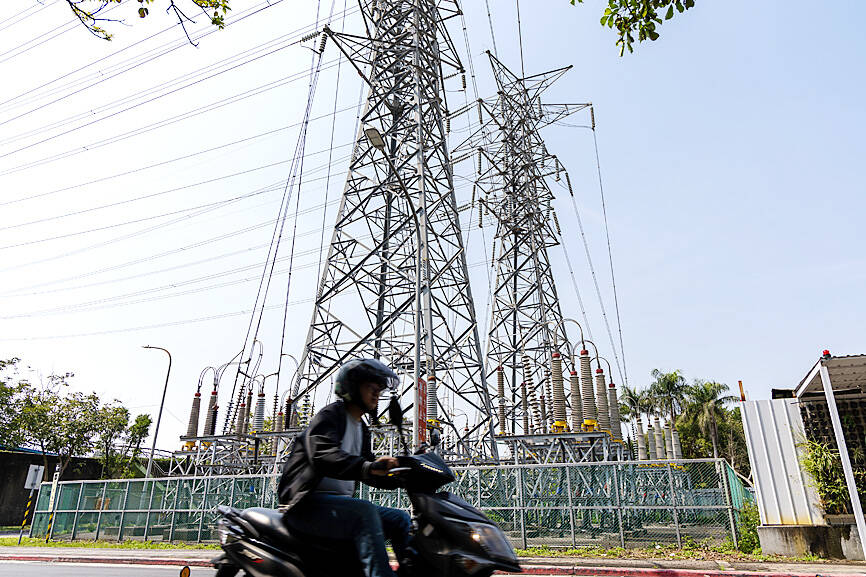Taiwan’s power consumption is to increase faster at an annual compound growth rate of 2.5 percent over the next five years, mainly driven by an eightfold surge in electricity usage by artificial intelligence (AI) applications, the Energy Administration said yesterday.
The latest forecast represented an increase from the 2 percent growth estimated last year for the period from last year through 2029.
The annual growth rate from this year to 2033 is expected to reach 2.8 percent as new data centers for AI applications become operational, the administration said in a report.

Photo: CNA
The increase in demand comes as Taiwan is expected to undergo a strong economic recovery this year, the semiconductor industry expands capacity amid an AI boom and electric vehicles become more popular, the report said.
AI applications including AI-focused data centers would consume about 2.24 gigawatts (GW) of power in 2028, expanding eightfold from 240 megawatts last year, the administration said.
The latest forecast factored in the expected deployment of new data centers, likely from Apple Inc, Nvidia Corp and Amazon Web Services, in addition to existing centers operated by Google, Microsoft Corp and Nvidia.

Photo: Lin Jin-hua, Taipei Times
“Because of AI, Taiwan has to add 12 to 13 percent more capacity during peak load during the 2024-2029 period,” Energy Administration Director-General Yu Cheng-wei (游振偉) told a news conference in Taipei yesterday.
The administration identified this year to 2028 as the critical period when electricity consumption would spike due to rapid uptakes of AI data centers, large-language AI training models and supercomputer centers, which have not been included in the administration’s forecast before.
Peak load demand is expected to expand to about 4.21GW at night from 3.73GW this year, the administration said.
To ensure stable and sufficient supply, Taiwan Power Co (Taipower, 台電) would install more natural-gas generators, enhance electricity grid resilience by revamping electrical substations and expand green energy storage systems, Yu said.
He urged the public to support CPC Corp, Taiwan’s (台灣中油) deployments of new liquefied natural gas (LNG) terminals to regasify LNG before sending it to power stations.
The construction of new LNG terminals was suspended amid environmental concerns.
Taipower projected its reserve margin would improve to 13.3 percent in 2028 from 8.5 percent this year.
That figure is expected to climb to 23.8 percent in 2033, indicating that its electricity capacity would outgrow demand, or capacity adequacy, the state-run utility said.
Asked if the administration would consider restarting or delaying the shutdown of nuclear power plants, Yu said the administration would respect the legislature’s decision on the matter.
Renewable energy is to account for 20 percent of the total power supply in November 2026, rather than the government’s 2025 target, the third time the government has pushed back the goal.
Yu blamed a surge in power consumption for the delays, but said the deployment of renewable energy generation remains on track.
By the end of 2029, green energy is projected to make up about 25 percent of the total power supply, down from 27 percent estimated last year, largely due to increases in total power supply, the report said.

‘SWASTICAR’: Tesla CEO Elon Musk’s close association with Donald Trump has prompted opponents to brand him a ‘Nazi’ and resulted in a dramatic drop in sales Demonstrators descended on Tesla Inc dealerships across the US, and in Europe and Canada on Saturday to protest company chief Elon Musk, who has amassed extraordinary power as a top adviser to US President Donald Trump. Waving signs with messages such as “Musk is stealing our money” and “Reclaim our country,” the protests largely took place peacefully following fiery episodes of vandalism on Tesla vehicles, dealerships and other facilities in recent weeks that US officials have denounced as terrorism. Hundreds rallied on Saturday outside the Tesla dealership in Manhattan. Some blasted Musk, the world’s richest man, while others demanded the shuttering of his

ADVERSARIES: The new list includes 11 entities in China and one in Taiwan, which is a local branch of Chinese cloud computing firm Inspur Group The US added dozens of entities to a trade blacklist on Tuesday, the US Department of Commerce said, in part to disrupt Beijing’s artificial intelligence (AI) and advanced computing capabilities. The action affects 80 entities from countries including China, the United Arab Emirates and Iran, with the commerce department citing their “activities contrary to US national security and foreign policy.” Those added to the “entity list” are restricted from obtaining US items and technologies without government authorization. “We will not allow adversaries to exploit American technology to bolster their own militaries and threaten American lives,” US Secretary of Commerce Howard Lutnick said. The entities

Minister of Finance Chuang Tsui-yun (莊翠雲) yesterday told lawmakers that she “would not speculate,” but a “response plan” has been prepared in case Taiwan is targeted by US President Donald Trump’s reciprocal tariffs, which are to be announced on Wednesday next week. The Trump administration, including US Secretary of the Treasury Scott Bessent, has said that much of the proposed reciprocal tariffs would focus on the 15 countries that have the highest trade surpluses with the US. Bessent has referred to those countries as the “dirty 15,” but has not named them. Last year, Taiwan’s US$73.9 billion trade surplus with the US

Prices of gasoline and diesel products at domestic gas stations are to fall NT$0.2 and NT$0.1 per liter respectively this week, even though international crude oil prices rose last week, CPC Corp, Taiwan (台灣中油) and Formosa Petrochemical Corp (台塑石化) said yesterday. International crude oil prices continued rising last week, as the US Energy Information Administration reported a larger-than-expected drop in US commercial crude oil inventories, CPC said in a statement. Based on the company’s floating oil price formula, the cost of crude oil rose 2.38 percent last week from a week earlier, it said. News that US President Donald Trump plans a “secondary